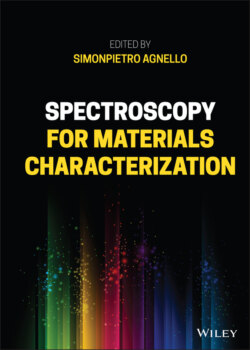Читать книгу Spectroscopy for Materials Characterization - Группа авторов - Страница 54
3.2.2 Nonlinear Optics: Basis and Applications 3.2.2.1 Second Harmonic Generation and Sum Frequency Generation
ОглавлениеSecond harmonic generation (SHG) is a nonlinear optical phenomenon in which two photons of the same frequency, interacting in a nonlinear material, are converted in a single photon with doubled frequency [22]. The polarization of a medium excited by an electrical field can be expressed as [19, 20]:
(3.4)
where, in general, χ (n) is a tensor. The first term of the equation describes the phenomena usually encountered in linear optics, while the other describes nonlinear effects at different orders in the electric field. Under certain conditions (χ (2) ≠ 0, as generally occurs in a non‐centrosymmetrical medium), two photons at the same frequency ω 1, passing through an appropriate medium, are combined to generate a new photon with a doubled frequency (2ω 1). The process follows the laws of energy (ω 1 + ω 1 = 2ω 1) and momentum conservation () and in not‐depleted pump condition (that is, negligible pump absorption) it is possible to describe the intensity of the new beam as [19, 20]:
(3.5)
where n is the refractive index, L is the optical path within the nonlinear material, Δk = k 2 − 2k 1 is the so‐called phase mismatch, and χ eff is the effective susceptibility which is a certain combination of the components of the χ (2) tensor, which depends on the material and on its orientation. The intensity of the new beam depends on the square of the incident beam intensity, on the length L (with a quadratic dependence if Δk = 0), and on the degree of phase mismatch. Fulfilling the condition Δk = 0, named phase matching, gives maximally efficient SHG, and corresponds to the conservation of momentum in the process. It can be seen as a situation in which first and second harmonic beams propagate in the medium with the same speed. In order to achieve this, the refractive index at ω and 2ω has to be the same. Although this is not generally possible in isotropic media, such a limitation can be overcome by using (uniaxial) birefringent media such as beta‐barium borate (BBO). The latter display two different refractive indexes, ordinary (n o), and extraordinary (n e), for beams with two orthogonal polarizations, where the extraordinary index also depends on the angle θ between the of the beam and the optical axis of the crystal. Thus, one can achieve phase matching, for example, if the beam at ω propagates as an ordinary beam, while the beam at 2ω propagates as an extraordinary beam. Then, changing the orientation of the crystal, it is possible to find an angle θ for which n e(2ω, θ) = n o(ω), fulfilling the phase matching condition.
Because femtosecond pulses are intrinsically broadband, another important parameter in SHG is the extent of spectral bandwidth which is effectively doubled (acceptance bandwidth), not necessarily coincident with the whole pulse bandwidth. In fact, the phase matching condition is exactly fulfilled only at a given wavelength, and therefore it cannot be exactly fulfilled across the entire pulse bandwidth. In practice, assuming that the first harmonic beam at λ 1 propagates as an ordinary beam, and a SHG beam is produced as an extraordinary beam at λ 2 = λ 1/2, the portion dλ 1 of the doubled pulse bandwidth is given by [23]:
(3.6)
Therefore, to increase the bandwidth of the doubled beam, it is necessary to decrease the crystal thickness L, at the cost of SHG efficiency (proportional to L 2). Therefore, according to the experimental requirements, one needs to find the right compromise between the two needs.
SHG is a specific nonlinear process which involves two photons with the same energy. Other second‐order nonlinear processes are possible, such as sum and difference frequency generation (SFG and DFG), where two photons with different energies combine together into a third photon. As for SHG, these processes need to satisfy energy and momentum conservation, which for SFG are expressed by: ω 3 = ω 1 + ω 2 and (equations for DFG have a minus sign). Also here, phase matching can be achieved within a birefringent nonlinear crystal. As compared to the efficiency equation reported in Eq. (3.5), the intensity of the pulse obtained by SFG or DFG depends on the product of the two incoming intensities () [24].
